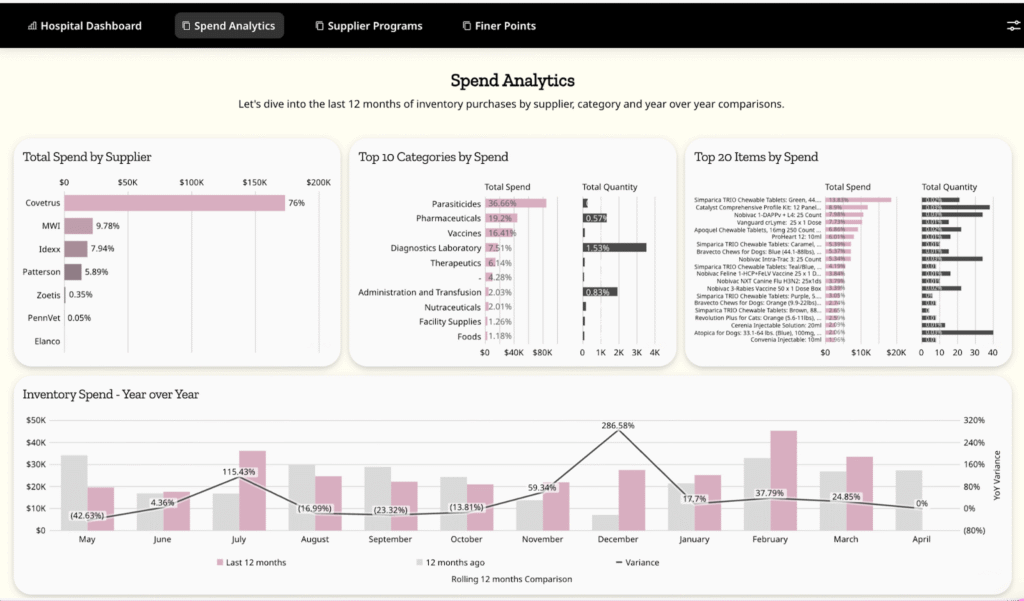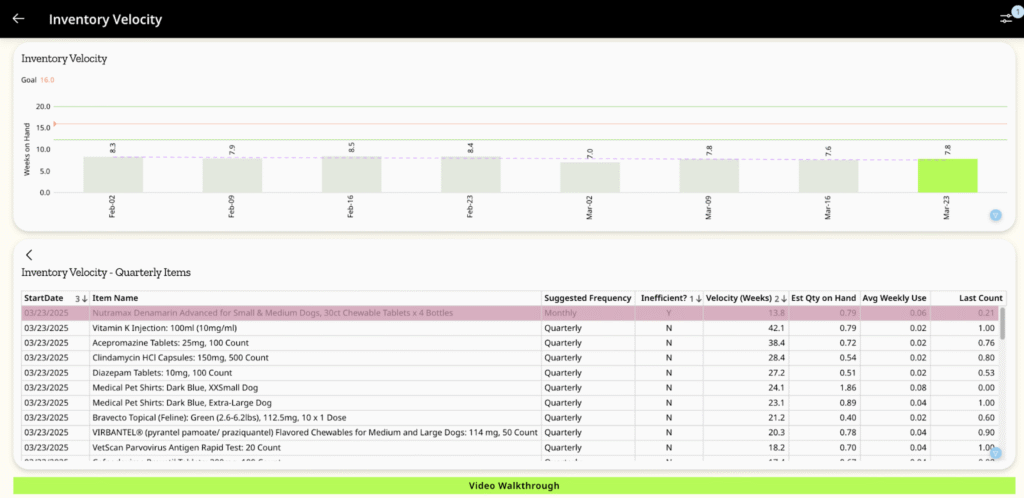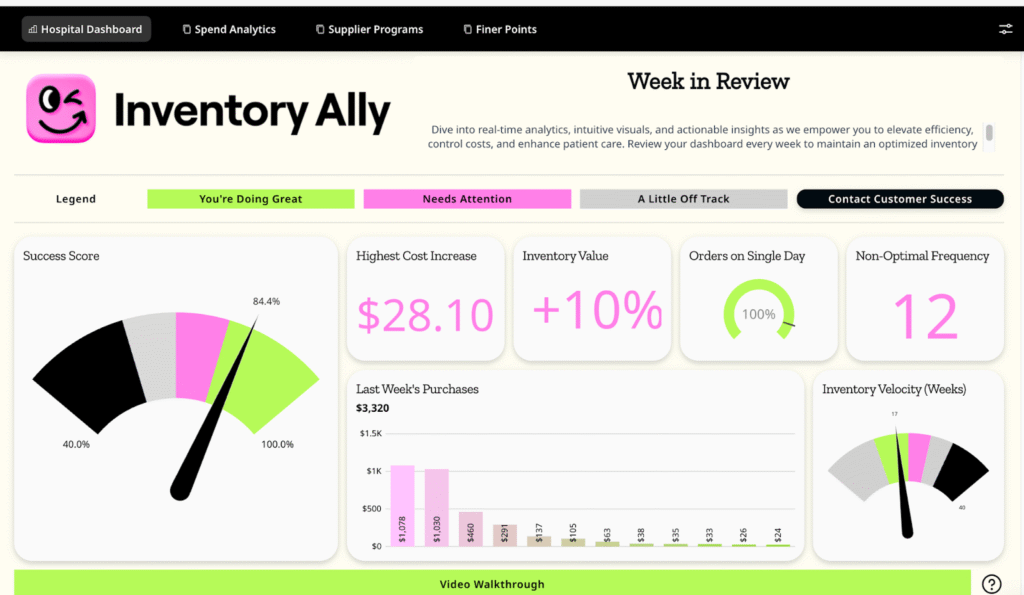Inventory is one of the biggest line items in any veterinary clinic, right behind payroll. When it’s under control, life is easier: patients get what they need, shelves stay organized, and the practice keeps more cash in the bank. When it’s not, the problems pile up fast: expired meds, wasted money, and those frustrating “sorry, we’re out” moments.
The upside? A few smart systems can completely change how your practice handles inventory. Below are 12 practical veterinary inventory management tips — strategies that save time, reduce waste, and protect your margins, all while keeping patient care front and center.
Tracking & Organization

1. Track What You Actually Use
If you’ve ever waited until year-end to count every pill, suture, and syringe, you know how painful that process is, and how unreliable the numbers can be. A better system is cycle counts: small, frequent spot checks on different categories of products.
For example, one week you might count all injectables, the next week your surgical supplies, and the week after that your preventives. Spreading the work across the year keeps your numbers accurate in real time and lets you catch discrepancies early, before they turn into missing stock or blown budgets.
Cycle counts also highlight patterns: are some products vanishing faster than expected? Are others piling up? These small insights let you fine-tune orders and prevent waste before it gets expensive.
The takeaway: accurate counts are the foundation of inventory management. With them, reorder points, budgets, and reports become useful tools instead of guesses.
→ Read more: 10 Common Veterinary Inventory Mistakes and How to Avoid Them
2. Prioritize Your Top Products
Not all items on your shelves are created equal. A box of gauze running low isn’t the same emergency as running out of your go-to antibiotic or heartworm preventative. That’s why one of the most effective systems for veterinary inventory management is the ABC method: focus most of your attention on the small set of products that matter most.
In most clinics, about 20% of items account for 80% of usage and revenue. These “A” items are your heavy hitters — vaccines, controlled drugs, fluids, and other essentials that keep the practice running. They need frequent monitoring and tighter reorder thresholds. “B” items are moderately important, checked on a biweekly or monthly basis. And “C” items are low-value or slow-moving products that can be reviewed less often without risk.
This prioritization ensures you’re spending time where it matters most. Instead of tracking every roll of tape, you’re protecting the drugs your practice can’t function without.
The takeaway: not every product deserves equal attention. Focus on the 20% that drive care and revenue, and manage the rest on a lighter schedule.
3. Use First-In, First-Out (FIFO)
Every veterinary practice has discovered an expired box of vaccines or antibiotics tucked in the back of the fridge. It’s frustrating, wasteful, and entirely preventable. The fix is a simple but powerful principle: First-In, First-Out (FIFO).
FIFO means the oldest stock gets used first. When new shipments arrive, place them behind the existing supply so staff naturally reach for the older items first. For refrigerated products, this might mean a quick reshuffle when you unpack boxes. For shelves, it means training the team to pull from the front and restock from the back.
The takeaway: FIFO is one of the simplest strategies to adopt, but also one of the most effective. With clear shelving habits and a little training, you can cut waste and keep inventory working for you.
4. Improve Your Storage
A messy pharmacy or stockroom not only looks bad but also wastes time, causes errors, and makes it harder to see when supplies are running low. Investing in better veterinary storage solutions and organization habits pay for themselves in efficiency.
Start with the basics: give every product a designated primary location and a clearly marked backup spot for overflow. Use shelf labels or bin stickers so staff always know where items belong. Color-coding by product type (e.g., red for controlled substances, blue for vaccines) helps new staff navigate quickly, even in stressful situations.
Small upgrades can make a big difference: clear storage bins for small items, dividers in drawers for syringes or sutures, or rolling carts stocked with surgery essentials. These aren’t cosmetic changes; they reduce the number of minutes staff spend hunting for supplies and minimize the risk of duplicate orders because “we didn’t realize we already had some.”
The takeaway: organization is an overlooked form of cost control. Simple storage systems free your team to focus on patient care instead of playing detective in the stockroom.
5. Use Technology to Automate the Busywork

Even the most organized shelves won’t save you if your tracking system is stuck on sticky notes and guesswork. Manual methods — writing items on a “want list,” moving reorder tags from one box to another, or updating spreadsheets — depend on people remembering every step in the middle of a hectic shift, and one slip can throw off your entire count.
That’s where technology makes a difference. Most practice management systems include basic inventory features like reorder alerts, usage tracking, and sales reports. These tools are useful, but they’re built for transactions, not for managing the whole inventory picture. They don’t account for in-house use, substitutions, or seasonal swings that change what you actually need on the shelf. As a result, teams often end up juggling spreadsheets on top of their PIMS to close the gaps.
Dedicated inventory platforms go further. Software like Inventory Ally pulls together both what’s sold to clients and what’s consumed in-house, then reconciles that against your order history. The result is a much more accurate, always-current view of stock levels. Instead of relying on someone to notice the reorder tag at the bottom of the box, you’ll get automatic alerts when it’s time to place an order. And rather than manually guessing at quantities, the system suggests replenishment amounts based on your own usage patterns, seasonality, and vendor trends. That combination helps you prevent both stockouts and over-ordering before they happen.
How Inventory Ally automates this in real life
- Tracks the whole picture: blends PIMS transactions with order history and in-house consumption, so counts reflect reality, not just invoices.
- Predicts what you’ll need: analyzes your usage patterns and seasonality, then recommends right-sized replenishment.
- Alerts on a rhythm: generates optimized weekly ordering cycles so you place one confident order instead of firefighting.
- Reports what matters: clear dashboards expose costs, usage, and opportunities to cut waste and stockouts.
The takeaway: technology doesn’t replace good habits, it reinforces them. By letting software handle the tedious tracking and math, your team can spend more time on patient care instead of paperwork.
→ Learn how Inventory Ally works or Schedule a free demo
Ordering & Stock Control

6. Set Reorder Points and Safety Stock
Too many clinics rely on the “eyeball method”: shake the bottle, peek at the shelf, and hope it lasts until the next order. It works… until it doesn’t. A smarter approach is to set clear reorder points (the quantity that triggers a new order) and keep a small buffer of safety stock for critical items.
Reorder points can be as simple as a tag placed halfway through a box of syringes. But static methods don’t adapt when usage changes. That’s why many clinics turn to technology. Inventory Ally tracks real usage in real time and automatically recalculates reorder needs as patterns shift. When stock dips, you get timely alerts and right-sized order suggestions instead of guesswork.
Safety stock is still your insurance policy. For essentials like fluids, anesthetics, and antibiotics, keep a little extra on hand to cover unexpected spikes in demand or supplier delays. Two weeks’ worth is a common target, but adjust based on your caseload and delivery times.
The takeaway: reorder points and safety stock shift inventory from reactive to proactive. With clear thresholds and the right tools to update them automatically, your shelves stay ready for the next patient.
7. Consolidate Orders and Vendors
Ordering feels simple until you realize how much time it eats up — searching catalogs, comparing prices, unpacking deliveries, reconciling invoices. The more suppliers you juggle, the more complicated (and expensive) it gets.
A better system is to place orders on a set schedule (weekly or biweekly works for most clinics) and lean on fewer suppliers whenever possible. Consolidating orders reduces shipping fees, simplifies invoice management, and often earns better pricing or rebates. Many distributors reward consistency and volume with perks you’ll miss if your orders are scattered.
That doesn’t mean putting all your eggs in one basket. For critical drugs, always keep a backup supplier in mind. But for most products, fewer vendor relationships managed well are far more efficient than spreading orders thin.
Technology makes this even easier. Inventory Ally, for example, generates a single weekly buy list based on your real usage, so you can place one confident order instead of scrambling with several small ones.
The takeaway: every extra order costs time and money. By consolidating vendors and creating a predictable ordering rhythm, you make purchasing simpler and give your team more bandwidth for patients.
8. Plan Ahead for Backorders
Few things throw a clinic off balance faster than learning a key medication is backordered, usually right when you need it most. Unfortunately, supply chain hiccups are a reality in veterinary medicine, which means every practice needs a plan B.
Start by monitoring supplier alerts so you know about shortages before they reach your shelves. When a product does go on backorder, post a clear note in its storage spot or flag it in your PIMS so no one accidentally prescribes what you don’t have. Pair that with a list of suitable alternatives — the backup antibiotic, the other vaccine brand, so doctors and technicians can pivot quickly without delaying treatment.
Communication is just as important as preparation. Share backorder updates in team meetings or group chats so everyone knows what’s available and what isn’t. This prevents frustration at the front desk and keeps client conversations smooth.
The takeaway: backorders can’t be eliminated, but they can be managed. With foresight and clear communication, you turn a potential crisis into a small adjustment.
Financial Management

9. Streamline and Standardize Your Formulary
It’s natural to want options on the shelf — maybe two flea preventives to suit client preferences, or more than one NSAID in case a pet doesn’t tolerate the first choice. The intention is good, but in practice it ties up cash, clutters your pharmacy, and increases the risk of products expiring before they’re used.
The fix is to simplify your formulary. Decide which products truly earn their place on the shelf and cut back on duplicates or slow movers. For example, you might stick to one trusted NSAID, one broad-spectrum antibiotic, and one flea/tick line you believe in. If a client wants a different option, you can special order it or direct them to your online pharmacy rather than keeping every variation in stock.
Inventory Ally can make this process easier by flagging duplicates and surfacing low-use items in your reports, so you can see which products are really pulling their weight. Think of it like shelf space: every item should earn its “rent” by moving regularly — if it sits too long, it’s costing the practice instead of contributing.
Streamlining doesn’t mean sacrificing care. It means choosing the products you know are reliable, effective, and actually used. It also makes training staff easier, since everyone becomes familiar with a smaller, more consistent set of items.
The takeaway: every extra product on your shelf is money sitting idle. By standardizing around proven, high-use items, you cut waste, improve efficiency, and keep more cash flowing back into your practice.
10. Monitor Your Costs and Turnover

Inventory isn’t just about shelves; it’s also a major line on your profit and loss statement. Keeping an eye on the right numbers helps you see whether your system is working or quietly draining revenue.
Start with Cost of Goods Sold (COGS). A common rule of thumb is that well-run practices keep COGS around 18–20% of revenue, but that number only tells part of the story. Different practice types and sizes run very different margins:
- ER and Specialty hospitals: often closer to 8–12%, since services contribute more heavily to revenue.
- General practices: usually fall near the 18–20% range.
- Large animal practices: can run much higher, sometimes in the 30%+ range, because product sales make up a bigger portion of revenue.
- Larger hospitals vs. smaller clinics: bigger practices often see lower COGS percentages thanks to higher service-to-product ratios.
That’s why it’s important not to benchmark blindly. Instead of aiming for a single target, measure against what’s healthy for your practice type and size — and track trends over time to catch early signs of over-ordering, undercharging, or waste.
Next, look at inventory turnover — how many times you sell and replace your average stock each year. A simple rule of thumb is 6–8 turns annually across the board, but a more accurate picture comes from looking at product categories:
- A products (high-value, high-use essentials): should turn 40–50 times per year (weekly).
- B products (moderate-use items): typically turn 12–16 times per year (monthly).
- C products (low-use or slow movers): may turn only 4–8 times per year.
“Without a clear baseline to start from, getting your inventory on track can be an overwhelming endeavor. An ABC analysis, or similar approach, can help identify the 20% of items that have 80% of the impact. We like to start there.”
Nicole Clausen, Inventory Ally Co-Founder
Another helpful metric is the value of inventory on hand as a percent of revenue. Practices carrying around 20% of their average monthly revenue in inventory are usually in a healthy zone, though this benchmark varies with hospital size and specialty.
That’s why we built Inventory Ally with dashboards that go beyond basic PIMS reports. By combining sales, in-house use, and order history, we give you a truer picture of COGS and turnover. You can see which products are tying up cash, which move quickly, and where shrinkage is happening, all in one place. Reviewing these numbers monthly turns them into an early warning system, so you can act before small inefficiencies turn into significant costs.
The takeaway: when you track COGS and turnover consistently, you’re not just crunching numbers, you’re protecting your margins. Even a few percentage points saved can put thousands of dollars back into your practice each year.
→ Read more: How to Run a More Profitable Veterinary Practice
Team & Culture

11. Train and Involve Your Team
Even the best inventory system will fail if it relies on just one person. In busy clinics, shelves get raided, supplies get shuffled, and without shared responsibility, things slip through the cracks.
Start by assigning clear ownership. Designate an inventory manager to oversee ordering and tracking, and appoint a backup so the process doesn’t grind to a halt when someone’s on vacation. Then go one step further: give every team member a role. Technicians can “own” their zones and be responsible for keeping them organized and reporting low stock. Reception staff can help flag client-facing items like diets or preventives.
Training is the glue that holds this together. Show staff how to read reorder tags, where to log shortages, and what the protocol is when something’s running low. When everyone understands the process and feels responsible for it, you create a culture where inventory management is part of patient care, not an afterthought.
The takeaway: inventory works best as a team sport. With clear roles and simple training, you transform it from one person’s headache into a shared system that keeps the whole clinic running smoothly.
→ Read more: Key Roles and Responsibilities in Veterinary Medicine
12. Celebrate the Wins
Inventory management isn’t exactly the kind of work that earns standing ovations — but it should. Every time your team prevents a stockout, avoids an emergency order, or saves the practice money by catching expiring products early, that’s a real win worth recognizing.
Celebrating those wins reinforces good habits. It can be as simple as a shoutout in a staff meeting (“Thanks to Maria for catching those short-dated vaccines before they expired”) or a quick note in the group chat when a new system pays off. These small acknowledgments signal to the team that their attention to detail matters, and that inventory success is practice success.
Over time, positive reinforcement builds momentum. Instead of inventory being a chore everyone avoids, it becomes part of the clinic’s shared pride — another way the team contributes to excellent patient care.
The takeaway: When you celebrate the small victories in inventory, you encourage consistency, teamwork, and a culture of accountability. Those habits add up to big results for your practice’s bottom line and peace of mind.
From Chaos to Control

Inventory doesn’t have to be a constant source of stress. With the right systems in place, you can turn it into one of the smoothest parts of running your practice.
The payoff is real: fewer stockouts, less waste, stronger margins, and a team that spends more time on patient care instead of chasing supplies. Even small improvements compound quickly: shaving a few percentage points off COGS or preventing a handful of expired products can mean thousands of dollars back each year.
The good news? You don’t have to overhaul everything overnight. Start with one or two changes this month — maybe cycle counts, maybe tighter reorder points — and build from there. With steady adjustments, inventory can shift from a constant scramble to a reliable system that works as hard for your practice as you do for your patients.
Ready to Make Inventory Easier?

Inventory doesn’t have to be complicated — and getting started with Inventory Ally isn’t either. A common worry is that new systems will be time-consuming or expensive to set up, but Inventory Ally is built to take that weight off your team.
It learns and self-optimizes automatically as you use it, so you don’t need perfect data or a big rollout plan before you begin. In fact, most clinics get fully dialed in with just a couple of hours spread over a few weeks.
From there, the system goes beyond basic tracking: it blends sales, in-house use, and order history to predict what you’ll need, alert you on a steady rhythm, and highlight where money is being wasted.
The result: fewer stockouts, less waste, lower costs, and more time for your team to focus on patient care instead of paperwork.

